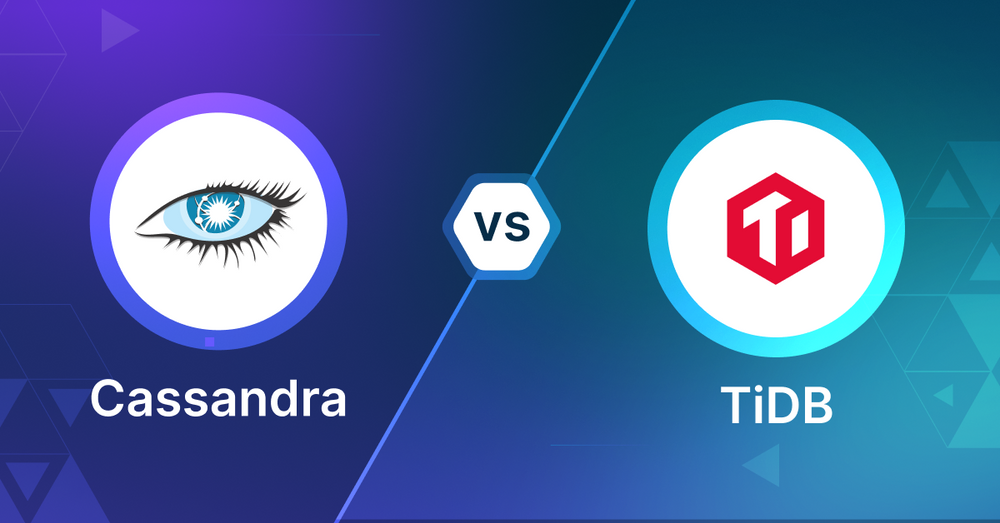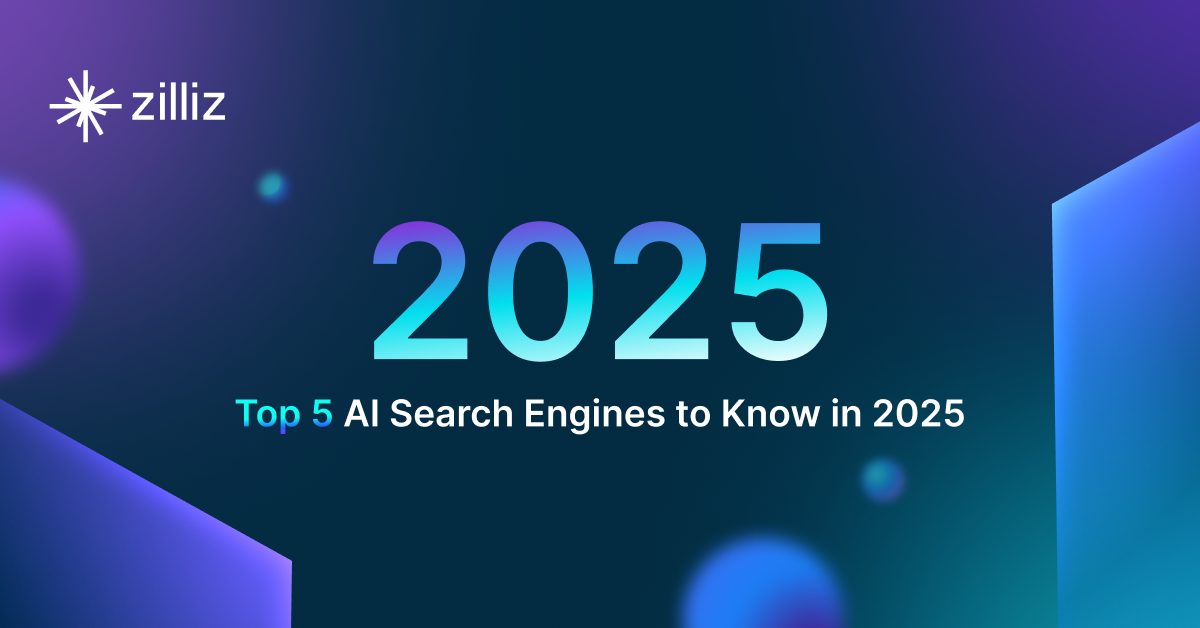Apache Cassandra vs TiDB: Choosing the Right Database for Your AI Applications

With the rise of AI-driven applications and the growing need to manage vast amounts of unstructured data, vector search have become essential for modern AI applications and use cases such as product recommendations, natural language processing (NLP), and image analysis. Two prominent options are Apache Cassandra and TiDB. Both systems are renowned for their scalability, distributed architectures, and ability to manage large datasets. However, they differ in many ways, from their core architecture to how they handle vector search functionality.
This article will compare Apache Cassandra and TiDB to help you choose the best solution for your vector search needs. We will break down their search methodologies, data handling capabilities, performance, scalability, and more differences. Let’s begin by understanding the concepts of vector search and vector database and why they matter in modern AI and data applications.
What is Vector Search and a Vector Database?
Before we introduce and compare Apache Cassandra and TiDB, let's first understand the concepts of vector searches and vector databases.
A vector search or vector similarity search refers to searching data points stored as vectors (numeric representations). For instance, when dealing with textual data, words or phrases are transformed into vector embeddings that capture their semantic meaning. This approach allows the system to perform similarity searches, like identifying text passages with similar meanings or finding images that resemble a given query image.
A vector database is designed to store and query high-dimensional vectors efficiently. In other words, vector databases are purpose-built solutions for performing vector searches. Unlike traditional relational databases, vector databases enable AI-driven applications like recommendation systems, facial recognition, and natural language processing (NLP) tasks by allowing for similarity search, which compares vectors to find nearest neighbors or similar items. They also play a crucial role in Retrieval Augmented Generation (RAG), a technique that enhances the performance of large language models (LLMs) by providing external knowledge to reduce issues like AI hallucinations.
There are many types of vector databases available in the market, including:
- Purpose-built vector databases such as Milvus, Zilliz Cloud (fully managed Milvus)
- Vector search libraries such as Faiss and Annoy.
- Lightweight vector databases such as Chroma and Milvus Lite.
- Traditional databases with vector search add-ons such as TiDB and Apache Cassandra
Overview of Apache Cassandra
Apache Cassandra is a highly scalable, distributed NoSQL database designed to handle massive amounts of data across commodity hardware. Originally developed by Facebook, Cassandra is known for its ability to provide high availability, fault tolerance, and horizontal scalability without a single point of failure.
Core Features and Strengths of Apache Cassandra
- Decentralized architecture: Every node in the Cassandra cluster is equal, meaning there’s no master node. This provides excellent fault tolerance and allows easy horizontal scaling.
- Linear scalability: As you add more nodes to the cluster, performance improves linearly, making it ideal for applications with rapidly growing datasets.
- Tunable consistency: Cassandra offers tunable consistency, allowing developers to choose between eventual and strong consistency, depending on the application’s needs.
- Write-heavy workload support: Cassandra excels in scenarios with frequent write operations, such as logging or sensor data collection.
Vector Search in Apache Cassandra
While Apache Cassandra is not natively designed as a vector database, its integration with DataStax and custom plugins allows it to support vector search functionalities. These integrations allow Cassandra to handle vector embeddings and allow similarity searches, particularly when combined with machine learning frameworks.
Implementing vector search in Cassandra usually leverages external libraries, which means additional setup and customization may be required to achieve optimal vector search performance. However, once configured, Cassandra’s distributed nature enables it to perform large-scale vector searches efficiently across many nodes.
Overview of TiDB
TiDB, developed by PingCAP, is an open-source, distributed SQL database that offers hybrid transactional and analytical processing (HTAP) capabilities. TiDB is MySQL-compatible, making it easy to adopt for teams already familiar with the MySQL ecosystem.
Core Features and Strengths of TiDB
- Distributed SQL: TiDB offers horizontal scalability like NoSQL databases while retaining the relational model of SQL databases. This makes it highly flexible for handling both transactional and analytical workloads.
- HTAP architecture: TiDB can process transactional (OLTP) and analytical (OLAP) workloads in a single database, reducing the need for separate systems.
- MySQL compatibility: TiDB is compatible with MySQL, making it easy to integrate into existing environments that rely on MySQL without significant changes to the application code.
- Auto-sharding: TiDB automatically shards data across nodes, improving read and write performance while maintaining strong consistency.
Vector Search in TiDB
TiDB supports vector search through integration with external libraries and plugins, allowing for efficient management and querying of vectorized data. TiDB’s HTAP architecture is beneficial for performing vector searches alongside transactional and analytical workloads, making it a versatile option for businesses needing these capabilities.
Including vector search functionalities in TiDB requires additional configuration, but once set up, the system can handle large-scale vector queries with its distributed architecture. The SQL compatibility also allows developers to combine vector search with traditional relational queries, offering more flexibility for complex applications.
Key Differences: Apache Cassandra vs TiDB
While both Apache Cassandra and TiDB can support vector searches, there are significant differences in their architectures, methodologies, and functionalities. Here’s a comparison across various critical factors:
1. Search Methodology
- Apache Cassandra: Vector search in Cassandra is typically achieved through external plugins, which can make the process more manual and require additional setup. However, once configured, Cassandra’s distributed nature allows for efficient vector search over large datasets.
- TiDB: TiDB’s HTAP architecture enables it to handle vector search as part of its broader workload capabilities. By supporting both transactional and analytical queries, TiDB offers greater flexibility when combining vector searches with other queries.
2. Data Handling
- Apache Cassandra: Specializes in handling unstructured or semi-structured data with its flexible schema, making it ideal for applications with write-heavy workloads.
- TiDB: Excels at managing structured data but also offers flexibility with semi-structured data due to its SQL compatibility. The hybrid transactional and analytical architecture allows for a more integrated approach to handling data.
3. Scalability and Performance
- Apache Cassandra: Known for its linear scalability and ability to handle massive amounts of data across multiple nodes. It’s an excellent choice for applications that need to scale out quickly.
- TiDB: Also offers horizontal scalability, but its performance scales particularly well for workloads that require a combination of OLTP and OLAP. For applications that need to balance transactional queries with analytical workloads, TiDB’s performance can be more favorable.
4. Flexibility and Customization
- Apache Cassandra: Offers high flexibility in data modeling, allowing developers to define tables with varying schemas. However, customization for vector search requires additional integration with external libraries.
- Thanks to its compatibility with MySQL,** TiDB** is more flexible in combining SQL-based queries with vector searches. This flexibility can determine whether your team prefers working with relational databases while incorporating AI-driven workloads.
5. Integration and Ecosystem
- Apache Cassandra: Integrates well with cloud-native applications and other big data frameworks like Apache Kafka and Apache Spark. The DataStax Enterprise offering adds more enterprise-grade features, including enhanced vector search capabilities.
- TiDB: Has a strong integration with the MySQL ecosystem, making it easy to adopt for teams already using MySQL. TiDB also integrates with a wide range of data visualization and analytics tools.
6. Ease of Use
- Apache Cassandra: Requires a steeper learning curve, especially for teams unfamiliar with NoSQL databases. Implementing vector search functionality can add complexity.
- TiDB: Easier to adopt for teams already familiar with SQL databases. The MySQL compatibility reduces the learning curve and simplifies the implementation of vector search.
7. Cost Considerations
- Apache Cassandra: Open-source but requires significant infrastructure resources when scaling. Managed Cassandra services, such as DataStax Astra, may help reduce operational overhead but come with additional costs.
- TiDB: Also open-source, but the hybrid nature of the database can lead to cost savings by reducing the need for separate OLTP and OLAP systems. TiDB Cloud offers managed services, which can lower operational costs but may increase overall expenses depending on usage.
8. Security Features
- Apache Cassandra: Provides basic security features like authentication, role-based access control, and data encryption. However, more advanced security capabilities are available through DataStax Enterprise.
- TiDB: Offers comprehensive security features, including encryption, access control, and audit logging. For enterprise use cases, TiDB’s security capabilities are more robust compared to Cassandra’s open-source version.
When to Choose Apache Cassandra for Vector Search
- You need a highly distributed, fault-tolerant database that can handle large-scale, write-heavy workloads.
- Your application requires flexible data modeling, and eventual consistency can be tolerated in certain cases.
- You are comfortable setting up vector searches through external libraries or plugins.
- You prioritize scalability and fault tolerance over ease of use and advanced search functionalities.
When to Choose TiDB for Vector Search
- You need a SQL-compatible system that supports both transactional and analytical workloads.
- Your application relies on a mix of structured and semi-structured data, and you prefer SQL’s familiarity.
- You need an easier-to-implement vector search that integrates well with relational queries.
- You require a hybrid transactional/analytical database with strong scalability for mixed workloads.
When to Choose a Specialized Vector Database?
While both Apache Cassandra and TiDB offer vector search capabilities, they are not optimized for large-scale, high-performance vector search tasks.
If your application relies on fast, accurate similarity searches over millions or billions of high-dimensional vectors, such as image recognition, e-commerce recommendations, or NLP tasks, specialized vector databases like Milvus and Zilliz Cloud (the managed Milvus) are better suited. These databases are built to handle vector data at scale, using advanced Approximate Nearest Neighbor (ANN) algorithms (e.g., HNSW, IVF ) and offering advanced features like hybrid search (including hybrid sparse and dense search, multimodal search, vector search with metadata filtering, and hybrid dense and full-text search), real-time ingestion, and distributed scalability for high-performance in dynamic environments.
On the other hand, general-purpose systems like Apache Cassandra and TiDB are suitable when vector search is not the primary focus, and you’re handling structured or semi-structured data with smaller vector datasets or moderate performance requirements. If you already use these systems and want to avoid the overhead of introducing new infrastructure, vector search plugins can extend their capabilities and provide a cost-effective solution for simpler, lower-scale vector search tasks.
Using Open-source VectorDBBench to Evaluate and Compare Vector Databases on Your Own
VectorDBBench is an open-source benchmarking tool designed for users who require high-performance data storage and retrieval systems, particularly vector databases. This tool allows users to test and compare the performance of different vector database systems such as Milvus and Zilliz Cloud (the managed Milvus) using their own datasets and determine the most suitable one for their use cases. Using VectorDBBench, users can make informed decisions based on the actual vector database performance rather than relying on marketing claims or anecdotal evidence.
VectorDBBench is written in Python and licensed under the MIT open-source license, meaning anyone can freely use, modify, and distribute it. The tool is actively maintained by a community of developers committed to improving its features and performance.
Download VectorDBBench from its GitHub repository to reproduce our benchmark results or obtain performance results on your own datasets.
Take a quick look at the performance of mainstream vector databases on the *VectorDBBench Leaderboard.
Read the following blogs to learn more about vector database evaluation.
Further Resources about VectorDB, GenAI, and ML
- What is Vector Search and a Vector Database?
- Overview of Apache Cassandra
- Overview of TiDB
- Key Differences: Apache Cassandra vs TiDB
- When to Choose Apache Cassandra for Vector Search
- When to Choose TiDB for Vector Search
- When to Choose a Specialized Vector Database?
- Using Open-source VectorDBBench to Evaluate and Compare Vector Databases on Your Own
- Further Resources about VectorDB, GenAI, and ML
Content
Start Free, Scale Easily
Try the fully-managed vector database built for your GenAI applications.
Try Zilliz Cloud for FreeKeep Reading

Top 5 AI Search Engines to Know in 2025
Discover the top AI-powered search engines of 2025, including OpenAI, Google AI, Bing, Perplexity, and Arc Search. Compare features, strengths, and limitations.

Empowering Innovation: Highlights from the Women in AI RAG Hackathon
Over the course of the day, teams built working RAG-powered applications using the Milvus vector database—many of them solving real-world problems in healthcare, legal access, sustainability, and more—all within just a few hours.

Insights into LLM Security from the World’s Largest Red Team
We will discuss how the Gandalf project revealed LLMs' vulnerabilities to adversarial attacks. Additionally, we will address the role of vector databases in AI security.
The Definitive Guide to Choosing a Vector Database
Overwhelmed by all the options? Learn key features to look for & how to evaluate with your own data. Choose with confidence.